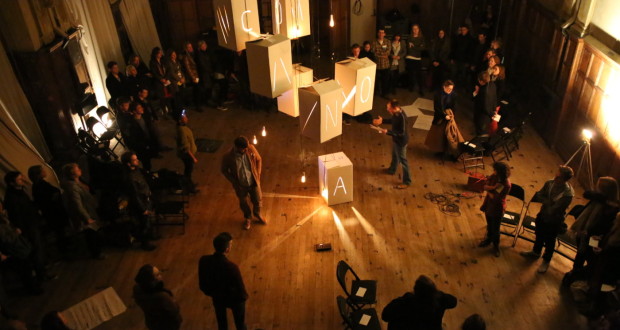Traditional theatre is making room for a different type of performance. More and more often, audiences are invited to throw themselves headfirst into a show rather than simply sit back and watch. But what does this mean? With everything from laptops to restaurants being described as ‘immersive’, Marni Appleton asks what we should expect from this type of theatre.
Punchdrunk are widely considered to be the pioneers of immersive theatre, having been at it since 2000. There is no such thing as a typical Punchdrunk show; projects range from interactive audio-tours to secret collaborations with musicians, so it is not always easy to identify the common ‘immersive thread’. Their most recent, large-scale UK show, The Drowned Man, was like being inside a dream. The venue started life as an abandoned postal sorting office, but you wouldn’t have been able to tell. The award-winning design transformed the space and no detail was overlooked: drawers were filled; real trees were brought in for the forests; authentic smells and textures were sourced, all of which heightened the senses and gave audience members very surreal experiences. The space could be treated as one giant art installation – it was possible to get a sense of the narrative without crossing paths with a single performer – or you could chase one of the many characters across four floors. The choice was yours. There is so much in a Punchdrunk show that you can never discover everything in a single visit; just one of the reasons Punchdrunk enjoys repeat visitors and dedicated fans, who love the fact there is always something new to be found.
Performances in The Drowned Man were mostly physical, set to an impressive (and loud) cinematic score, so opportunities to converse with the characters were thin on the ground. If you were very lucky, you might be selected for a sought-after ‘one on one’ experience, where a character would draw you into a room and interact with you alone. But aside from this, audience interaction with performers was fairly minimal. There were no opportunities to influence their journeys or the direction of the story; the next scene always continued as scripted.
Audiences have to be able to change or influence the narrative of the show.
Does this affect whether or not the show is immersive? David Frias-Robles, co-founder of the theatre company Myriad & Co thinks so. For him, audiences have to be able to change or influence the narrative of the show, for it to be considered immersive. ‘Of course there has to be a basic structure,’ he says. ‘But there also has to be some form of choice for the audience.’
David has worked extensively in immersive theatre. As well as establishing Myriad & Co, he has worked as actor and director on a range of projects including The Backstage Tour, shows with Secret Cinema and epoch’s The Factory, soon to be seen at VAULT Festival. One of David’s recent projects, Canvas City saw Canvas Bar in Old Street transformed into a 1930s speakeasy. Audience members came to the bar dressed in clothes from the era and were encouraged to adopt their own persona. As the night unfolded, the lines between performer and audience became blurred. There were three crucial, pre-planned moments, but in between those, audience members were able to aid and influence each character’s journey.
His idea of an immersive show is one where….every single detail that might betray the experience as a performance has been eliminated.
The only drinks available on the night were a selection of whisky-based cocktails served in tiny jars. This added to the authentic feel of the night, which was surprisingly effective, considering very little of the bar had been changed. For David, it is these details that are crucial. His idea of an immersive show is one where the audience is in costume, where a narrative has been built up before the performance itself, and where every single detail that might betray the experience as a performance has been eliminated. While this is almost impossible to achieve, the best immersive theatre, he says, comes very close.
If everyone is playing and no one is watching, do these events still count as theatre?
Coney is one of the companies producing ‘audience-led’ theatre. Coney’s A Small Town Anywhere and Early Days used the audience as the cast in shows that were part-game, part-improvisation and partly structured. There are a number of experiences that operate in a similar way, such as Heist by differencEngine and the recent New Atlantis by LAStheatre. But if everyone is playing and no one is watching, do these events still count as theatre? And if they are, this begs the question of live action role-play, murder mysteries and other similar games. Do these come under the umbrella of immersive theatre too?
With audience-led, fully participatory work at one end of the immersive spectrum, there are also supposedly immersive shows that sit right down at the other end of the spectrum. The word ‘immersive’ is often used in relation to shows that simply have non-traditional aspects or some immersive elements. The Roof at the National Theatre was a non-traditional performance staged in a car park, which made clever use of audio by giving each audience member a fancy pair of headphones. However, there was no interaction with the characters and there wasn’t even anywhere to go; viewers simply stood and watched the show instead of sitting down. Whilst this may have been different and exciting for immersive novices, it would have been a disappointment to anyone wanting to get properly stuck in. Many would argue that this was not representative of the genre.
Immersive shows are pushing and breaking down the boundaries of theatre and attracting new audiences.
While immersive theatre is difficult to define precisely, it is certainly enjoying a boom at the moment. Is it just a phase? Perhaps. But this writer hopes not. Immersive shows are pushing and breaking down the boundaries of theatre and attracting new audiences – many who aren’t regular theatregoers. As audiences, we should expect the unexpected from this type of show, but what does that mean in practical terms?
- Do your homework! Check the dress code and start time. Don’t start on the back foot.
- Choose a level of interactivity that you feel comfortable with. Build up gradually if you aren’t sure ‘immersive’ is for you.
- Choose your companions with care. Make sure they know what to expect and are comfortable with it. Take people you trust if you’re a bit nervous. It may not be the best place for a first date….though you’d certainly have lots to talk about!
- Go with an open mind and commitment. Interactive shows are, in part, only as good as the people who go along to them
Great theatre is often risky, and immersive shows are no exception. But throw yourself into the experience, and it might just be a revelation.
The Factory is at VAULT Festival on 28th February.
 Everything Theatre Reviews, interviews and news for theatre lovers, London and beyond
Everything Theatre Reviews, interviews and news for theatre lovers, London and beyond




This is one of the most brilliant articles today. thank you.
I’m going to try and see an immersive theatre at my very next opportunity…I’ve never encountered before this genre but it sounds really incredible. thank you.
Hi Hecter!
Thank you for your feedback. I’m really glad this article has inspired you to try out some immersive theatre – do let us know how you get on!
Marni
Because of you and your wonderful I attended event at factory vault about immersion last week.
It was a wonderful enjoyable time. Thank you once again.
Ever grateful.
Hecter.
This is a really great article both for immersive theatre newbies and those who have seen many productions that claim to be immersive and question what it really means.
As you acknowledge, there are many different ways the term can be interpreted and it is often (mis?)applied to any work with a non-traditional set up… it is also, of course, very en vogue with many bars and restaurants jumping on the band wagon. I would argue however that it doesn’t always need to be about audience participation. Two of the most ‘immersive’ experiences I have had were so, due to the way they totally engulfed my senses. These productions were ‘Hug’ by Verity Standen and Fuel Theatre’s ‘Ring’. They were both amazing sensory take-overs in which I was 100% present and within that moment – way more so than in the kind of action/narrative based theatre where you are able to interact with the actors and influence the plot. Punchdrunk are VERY good at what they do but if a company isn’t, I am often more aware of the third wall in these kinds of performances, than I am in a traditional theatre space.
Thanks for a great article. I am interested in whether you think these sensory immersive pieces are should be categorised under the term?